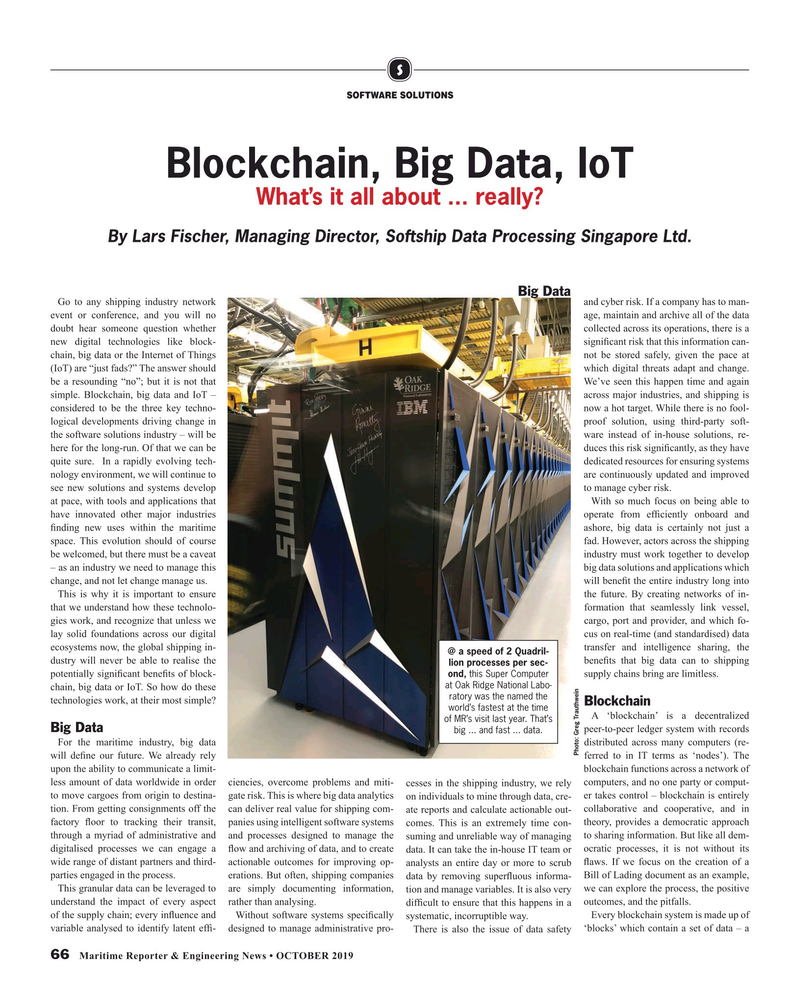
Page 66: of Maritime Reporter Magazine (October 2019)
Marine Design Annual
Read this page in Pdf, Flash or Html5 edition of October 2019 Maritime Reporter Magazine
S
SOFTWARE SOLUTIONS
Blockchain, Big Data, IoT
What’s it all about ... really?
By Lars Fischer, Managing Director, Softship Data Processing Singapore Ltd.
Big Data
Go to any shipping industry network and cyber risk. If a company has to man- event or conference, and you will no age, maintain and archive all of the data doubt hear someone question whether collected across its operations, there is a new digital technologies like block- signi? cant risk that this information can- chain, big data or the Internet of Things not be stored safely, given the pace at (IoT) are “just fads?” The answer should which digital threats adapt and change. be a resounding “no”; but it is not that We’ve seen this happen time and again simple. Blockchain, big data and IoT – across major industries, and shipping is considered to be the three key techno- now a hot target. While there is no fool- logical developments driving change in proof solution, using third-party soft- the software solutions industry – will be ware instead of in-house solutions, re- here for the long-run. Of that we can be duces this risk signi? cantly, as they have quite sure. In a rapidly evolving tech- dedicated resources for ensuring systems nology environment, we will continue to are continuously updated and improved see new solutions and systems develop to manage cyber risk. at pace, with tools and applications that With so much focus on being able to have innovated other major industries operate from ef? ciently onboard and ? nding new uses within the maritime ashore, big data is certainly not just a space. This evolution should of course fad. However, actors across the shipping be welcomed, but there must be a caveat industry must work together to develop – as an industry we need to manage this big data solutions and applications which change, and not let change manage us. will bene? t the entire industry long into
This is why it is important to ensure the future. By creating networks of in- that we understand how these technolo- formation that seamlessly link vessel, gies work, and recognize that unless we cargo, port and provider, and which fo- lay solid foundations across our digital cus on real-time (and standardised) data ecosystems now, the global shipping in- transfer and intelligence sharing, the @ a speed of 2 Quadril- dustry will never be able to realise the bene? ts that big data can to shipping lion processes per sec- potentially signi? cant bene? ts of block- supply chains bring are limitless.
ond, this Super Computer at Oak Ridge National Labo- chain, big data or IoT. So how do these ratory was the named the technologies work, at their most simple?
Blockchain world’s fastest at the time
A ‘blockchain’ is a decentralized of MR’s visit last year. That’s
Big Data peer-to-peer ledger system with records big ... and fast ... data.
For the maritime industry, big data distributed across many computers (re-
Photo: Greg Trauthwein will de? ne our future. We already rely ferred to in IT terms as ‘nodes’). The upon the ability to communicate a limit- blockchain functions across a network of less amount of data worldwide in order ciencies, overcome problems and miti- cesses in the shipping industry, we rely computers, and no one party or comput- to move cargoes from origin to destina- er takes control – blockchain is entirely gate risk. This is where big data analytics on individuals to mine through data, cre- collaborative and cooperative, and in tion. From getting consignments off the can deliver real value for shipping com- ate reports and calculate actionable out- theory, provides a democratic approach factory ? oor to tracking their transit, panies using intelligent software systems comes. This is an extremely time con- through a myriad of administrative and and processes designed to manage the suming and unreliable way of managing to sharing information. But like all dem- digitalised processes we can engage a ? ow and archiving of data, and to create data. It can take the in-house IT team or ocratic processes, it is not without its wide range of distant partners and third- actionable outcomes for improving op- analysts an entire day or more to scrub ? aws. If we focus on the creation of a parties engaged in the process. Bill of Lading document as an example, erations. But often, shipping companies data by removing super? uous informa-
This granular data can be leveraged to are simply documenting information, tion and manage variables. It is also very we can explore the process, the positive understand the impact of every aspect rather than analysing. dif? cult to ensure that this happens in a outcomes, and the pitfalls.
Every blockchain system is made up of of the supply chain; every in? uence and Without software systems speci? cally systematic, incorruptible way. variable analysed to identify latent ef? - designed to manage administrative pro- There is also the issue of data safety ‘blocks’ which contain a set of data – a 66 Maritime Reporter & Engineering News • OCTOBER 2019
MR #10 (66-73).indd 66 10/4/2019 12:23:34 PM

 65
65

 67
67
